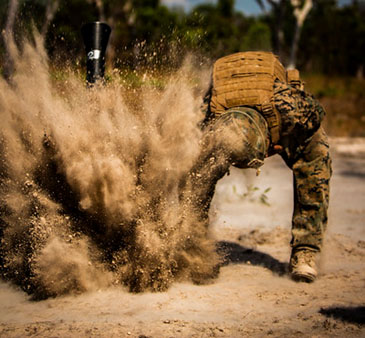Service members who experience a mild traumatic brain injury (mTBI) may be more likely to have sleep disturbances, which can negatively impact the recovery process after sustaining an injury. The glymphatic pathway is a network of connecting perivascular spaces (PVSs) in the brain that removes waste and is most active during sleep. Increased PVS burden, an indicator of glymphatic pathway dysfunction, has not only been observed in Veterans with poor sleep, but also linked to other conditions such as Alzheimer's disease and multiple sclerosis1.
Previous studies have examined the relationship between poor sleep and post-mTBI morbidity; however, the underlying mechanisms have not yet been established. To address this need, a recent study1 investigated the relationship between the number of mTBIs, poor sleep, and PVS burden in a group of Afghanistan and Iraq Veterans. The study sought to define the relationship between PVS burden and persistent post-concussive symptoms (e.g., headaches, dizziness, poor concentration, and depression) in the same cohort.
The researchers studied magnetic resonance imaging (MRI) data for 56 Veterans and used an automated imaging segmentation tool to quantify whole-brain PVS number, volume, morphology, and location. Their research found:
The study suggests that Service members who experience mTBI and have an increased PVS burden may be at risk of higher post-concussive symptoms, especially if they report sleep disturbances. Additional research is needed to determine whether increased PVS burden is a reliable biomarker of glymphatic dysfunction and associated long-term effects. This information can be used for risk stratification and return-to-duty assessments among Service members and also help with a recovery plan after mTBI.

1 Piantino, J., Schwartz, D. L., Luther, M., Newgard, C., Silbert, L., Raskind, M., Pagulayan, K., Kleinhans, N., Iliff, J., & Peskind, E. (2021). Link between Mild Traumatic Brain Injury, Poor Sleep, and Magnetic Resonance Imaging: Visible Perivascular Spaces in Veterans. Journal of neurotrauma, 38(17), 2391–2399. https://doi.org/10.1089/neu.2020.7447
This work was supported by the National Heart, Lung, and Blood Institute (NHLBI; K23HL150217-01), Department of Veterans Affairs Rehabilitation Research and Development Service Merit Review grant B77421, and National Institute of Aging (NIA; AG066518).
Your 15 minute session will timeout in approximately 10 minutes.
If you're in the middle of entering information, please close this warning and save your progress (if possible) or finish up your task.
If your session fully times out, you will lose any un-saved work.
Your current Blast Injury Research Program session has expired.
Your next click will take you away from the private area, and you will lose any work you have in-progress.
Please enter your email address, and try again.